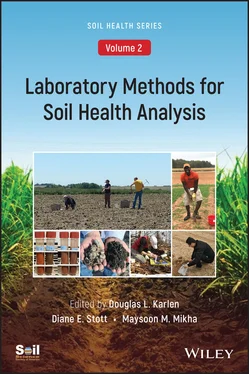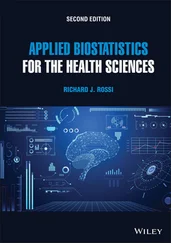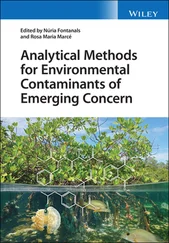Laboratory Methods for Soil Health Analysis, Volume 2
Здесь есть возможность читать онлайн «Laboratory Methods for Soil Health Analysis, Volume 2» — ознакомительный отрывок электронной книги совершенно бесплатно, а после прочтения отрывка купить полную версию. В некоторых случаях можно слушать аудио, скачать через торрент в формате fb2 и присутствует краткое содержание. Жанр: unrecognised, на английском языке. Описание произведения, (предисловие) а так же отзывы посетителей доступны на портале библиотеки ЛибКат.
- Название:Laboratory Methods for Soil Health Analysis, Volume 2
- Автор:
- Жанр:
- Год:неизвестен
- ISBN:нет данных
- Рейтинг книги:3 / 5. Голосов: 1
-
Избранное:Добавить в избранное
- Отзывы:
-
Ваша оценка:
- 60
- 1
- 2
- 3
- 4
- 5
Laboratory Methods for Soil Health Analysis, Volume 2: краткое содержание, описание и аннотация
Предлагаем к чтению аннотацию, описание, краткое содержание или предисловие (зависит от того, что написал сам автор книги «Laboratory Methods for Soil Health Analysis, Volume 2»). Если вы не нашли необходимую информацию о книге — напишите в комментариях, мы постараемся отыскать её.
Analyzing, comparing, and understanding soil health data Soil Health, Volume Two: Laboratory Methods for Soil Health Analysis
Laboratory Methods for Soil Health Analysis, Volume 2 — читать онлайн ознакомительный отрывок
Ниже представлен текст книги, разбитый по страницам. Система сохранения места последней прочитанной страницы, позволяет с удобством читать онлайн бесплатно книгу «Laboratory Methods for Soil Health Analysis, Volume 2», без необходимости каждый раз заново искать на чём Вы остановились. Поставьте закладку, и сможете в любой момент перейти на страницу, на которой закончили чтение.
Интервал:
Закладка:
Sampling decisions will vary based on assessment objective(s), geographic location, investigator preferences, and/or agroecosystem attributes. For initial soil health samplings, extra care is warranted since those data will ultimately be referenced as baseline data against which long‐term changes in soil properties are measured. After selecting an appropriate sampling design, the best approach for sample collection in order to meet project goals and soil conditions should be determined and documented in the metadata. For example, mechanical coring devices (handheld or machine‐driven) will often be used because they permit rapid collection of soil samples with a uniform cross‐sectional area. However, for soils with high near‐surface sand content or excessive stones, a compliant cavity method may be a preferable approach (USDA‐NRCS, 2004).
After carefully collecting soil samples, they should be placed in labeled plastic bags, sealed, stored in coolers with ice packs, and transported promptly to a laboratory where they can be held in cold storage (5 °C) until processed. Thick‐gauge polyethylene or double bags may be required to limit moisture loss.
Processing protocols should minimize changes in soil properties. For biological attributes, storage time even at 5 °C should be minimized. If extended storage of biological samples is necessary, freezing at −20 °C is recommended over air‐drying (Sun et al., 2015). For chemical soil health indicators, samples can be air‐dried at 35 °C for 3 to 4 d before sieving to remove rocks, root fragments, and non‐soil material. Some soil physical indicators (e.g. bulk density) should be determined using non‐disturbed samples, while coarse (~8 mm) sieving can be used to prepare samples for aggregate stability analysis (Vol. 2, Chapters 4and 5).
Though frequently overlooked, archiving of soil samples is critically important, especially for long‐term studies. Archived soil samples provide ‘time capsules’ for assessing temporal changes in soil properties and are particularly valuable as new analytical capabilities are developed (Boone et al., 1999). The amount of soil archived will vary by evaluator goals, available storage space, and projected future needs (e.g. research vs production‐scale monitoring), but in general several hundred grams of air‐dried soil should be archived from ‘time‐zero’ with additional amounts from key subsequent samplings. Archived soil samples should be kept in air‐tight, non‐reactive containers with secure lids and permanent labels. Samples should also be kept in a dry, secure location with moderate temperature conditions and a low probability of water or fire damage.
Field Evaluations
Field evaluations of soil health can often provide timely insights into soil condition ( Fig. 2.2). They can affirm the efficacy of current and previous soil and crop management decisions (e.g., tillage intensity, rotations, manure application) and thus help guide management changes to better align with goals of the land manager. Field evaluations can also help discern the value of more intensive, costly follow‐up assessments, and may confirm (or refute) findings from previous laboratory analyses.
Soil‐related information gathered during a field evaluation is strongly influenced by the approach taken, and much like the selection of sampling designs, the evaluator should be aware of tradeoffs associated with the selected approach. Therefore, attributes of field evaluations and their capacity to meet stated objectives should be carefully considered by the land manager prior to initiating assessments.
General Field Observations
Field‐scale soil health assessments should begin with general field observations such as aboveground biomass, plant growth characteristics and soil conditions. Since these observations are generally part of normal field management practices, they are a logical first step during soil health assessments to determine if more detailed, follow‐up evaluations are warranted. Moreover, much of this information may be obtained through conversations with the land manager. Common field observations outlined by Magdoff and Van Es (2009) include:
Are yields declining?
Do crops perform less well than those on neighboring farms with similar soils?
Do crops quickly show signs of stress or stunted growth during wet or dry periods? Figure 2.2 Generalized approaches to field evaluations of soil health. USDA‐NRCS photo credits: Field observations – Roberto Luciano; Visual soil evaluations – Roberto Luciano; Test kits – Susan Samson‐Liebig; Sensor‐based measurements – Keith Anderson.
Are there symptoms of nutrient deficiencies?
Are there increased problems with diseases or weeds?
Does the soil appear compacted?
Does it take more power to run field equipment through the soil?
Does the soil crust over easily?
Are there signs of runoff and erosion?
Are there changes in soil color?
On‐the‐ground observations of crop and soil conditions can be supplemented with aerial imagery to help identify potential production and environmental issues (Schepers et al., 2004). Doing so can efficiently guide follow‐up evaluations and potential management interventions in affected areas if image locations are georeferenced.
Descriptive soil health field assessments can be translated into semi‐quantitative formats using soil health scorecards. Developed in the early 1990s (Harris and Bezdicek, 1994), scorecards use stakeholder knowledge and field evaluations to identify relevant soil health indicators and assign an associated ranking as being healthy, impaired, or unhealthy (Romig et al., 1996). Scorecards rely on the evaluator’s senses (e.g., sight, feel, smell) and manager input to discern the quality or character of an attribute, making assessments unique to the individual.
Soil health scorecards and other semi‐quantitative evaluation approaches have been developed for many states in the USA following a collaborative process including farmers, conservationists, and scientists to identify relevant indicators and ranking criteria (USDA‐NRCS, 1999). Property‐specific pocket charts have also been developed based on associations between descriptive assessments and laboratory measurements (e.g, soil color categories with ranges of organic matter content) (Alexander, 1971). However, broad application of pocket charts for soil quality assessment has been limited because of the complexity and variability among soils. In the case of soil color, associations with soil organic matter content vary strongly with texture, soil depth, and land use (Wills et al., 2007), thereby constraining chart use to a limited geographical domain.
Visual Soil Evaluations
Visual soil evaluations are important components of soil health assessment. If done thoroughly and in a quantitative manner, visual soil evaluations can be integrated with broader land evaluation frameworks (Mueller et al., 2012; Pellant et al., 2020). As there are multiple soil evaluation methods currently in use (Ball and Munkholm, 2015), evaluators need to mindful of their intended application and respective strengths and weaknesses. The Visual Evaluation of Soil Structure (VESS) (Ball et al., 2017) and rangeland health assessment protocols (Pellant et al., 2020) represent approaches for cropland and rangeland, respectively.
The VESS was designed for arable production systems (Ball et al., 2017) based on the Peerlkamp Spade Test (Peerlkamp, 1959). It classifies top‐ and sub‐soil attributes into five scoring categories based on the size, shape, and visible porosity of soil aggregates, rooting characteristics, and presence/absence of macropores. VESS requires only a shovel and scoring guidelines (Scotland’s Rural College, 2019), so evaluators can quickly assess soil structure and assign a score between 1 (best) and 5 (worst). The tactile “hands‐on” nature of VESS enables it to work best when the soil is in a friable condition (neither too wet nor too dry). A limitation of VESS is that it does not work well in very sandy soils because of low structural cohesion (Franco et al., 2019).
Читать дальшеИнтервал:
Закладка:
Похожие книги на «Laboratory Methods for Soil Health Analysis, Volume 2»
Представляем Вашему вниманию похожие книги на «Laboratory Methods for Soil Health Analysis, Volume 2» списком для выбора. Мы отобрали схожую по названию и смыслу литературу в надежде предоставить читателям больше вариантов отыскать новые, интересные, ещё непрочитанные произведения.
Обсуждение, отзывы о книге «Laboratory Methods for Soil Health Analysis, Volume 2» и просто собственные мнения читателей. Оставьте ваши комментарии, напишите, что Вы думаете о произведении, его смысле или главных героях. Укажите что конкретно понравилось, а что нет, и почему Вы так считаете.












